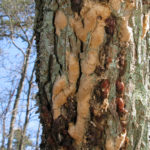
Spongy moth egg masses on the bark of a tree. Egg masses are pale brown and covered in hairs. Photo credit: Sandy Richard.
It’s never too early to protect your trees from spongy (previously gypsy) moth! Across the Central and Northeastern US spongy moths had a population boom this summer. Although we do not have firm predictions for next year yet, you can still start planning and protecting your trees now!
Fall is the perfect time to check your property for spongy moth eggs. Spongy moths aren’t picky about where they lay their eggs. Look for them on trees, houses, trailers, fence posts, and other surfaces near your home. Usually, a few egg masses won’t severely damage your tree, but if you find more than 10 it’s time to start thinking about treatment options. Here are the two main methods for managing eggs. First, you can manually remove them by gently scraping them with a knife or paint scraper. Throw the eggs in soapy water or in your freezer. Leave them for two or more days then dispose of them how you like. Second, you can chemically treat the eggs. Soak the eggs in a horticultural oil or insecticidal soap that is labeled for spongy moths. If you use this method, be sure that the oil or soap won’t damage the surface (e.g. house paint) under the eggs.
Both methods are effective at killing the eggs you can find and help to greatly reduce the spongy moth population. However, it’s very likely that you will miss some. Keep an eye on your trees in early spring and summer next year!
To find out more about the history of, current state of, and more management recommendations for spongy moth, check out EABU’s free webinar this Thursday, Sept. 27th at 11:00 AM EST. CCH credit is available for categories 2, 3A, and RT. Go to http://www.emeraldashborer.info/eabu.php to register!